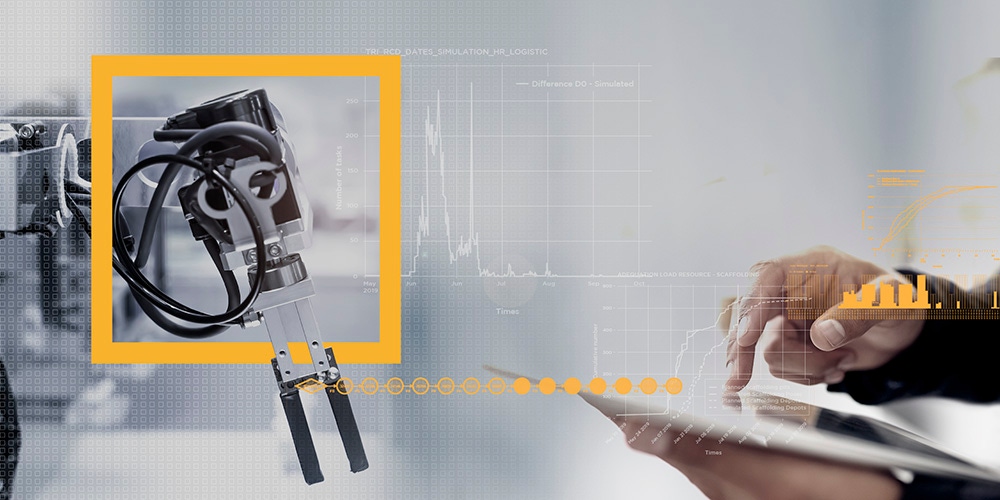Generating a Return on IIoT Data with SimulationGenerating a Return on IIoT Data with Simulation
January 19, 2022

Sponsored Content
By Michel Morvan
In the last five years investments in Industrial IoT (IIoT) have exploded. In 2016 the IIoT market was already valued at $115 billion and by 2023 it’s expected to touch almost $200 billion. But there’s a problem: while decision makers have access to more data than ever, they aren’t necessarily generating a return on that data.
IIoT systems gather data, and that data is necessarily about the past. Historical data can tell a story and by analyzing this data and determining correlations, companies can learn more about how their businesses work. But correlation is not cause, and trends in historical data cannot accurately predict the future. What’s more, an event that has never previously occurred cannot be predicted based on data from the past. If the future does not resemble the past – and which industrial leader truly believes that it will? – the investment in historical data will not help to set a good strategy for that future.
What’s more, even the most extensive IIoT systems cannot provide a total and unified view of an entire industrial system including its interconnected dynamics. As a result, significant parts of the corporate value chain are left unanalyzed and the impacts of decisions in one part of the business on other parts of that same business cannot be quantified. It’s a limited view of the value chain and it can cost a company dearly.
So, what’s a company to do if they want to find their forward and generate that return on data?
Connect their IIoT to a digital twin.
Unlocking Value with Simulation Digital Twins
A digital twin is a virtual representation that serves as the real-time digital counterpart of a physical object, process, or organization. While the terminology has changed over time, the basic concept of a digital twin model has remained fairly stable from its inception in 2002. For many people though, the words ‘digital twin’ conjure up an image of a 3D model of a physical object, yet this is rarely the case. Instead, these twins are simply digital representations of an individual asset, machine, or equipment piece; no 3D model or graphical representation is necessarily required, with many digital twins displaying nothing more graphically engaging than a dashboard.
As the trend towards adoption of digital twins gains momentum and the digital twin ecosystem rapidly expands, a new class of digital twins has appeared. More than just a representation of a single asset or machine, these new digital twins can model entire organizations, interconnected processes, and complex systems based on the evolving dynamics of the day-to-day operations of a business. Drawing on the power of simulation to accurately predict the future state of these complex systems, they are known as Simulation Digital Twins.
Simulation Digital Twins incorporate three fundamental advances to address the systemic challenges of making optimal choices in the world’s most complex industrial environments:
A 360° holistic view: Simulation Digital Twins can virtually replicate an entire ecosystem including all elements of an organization. A Simulation Digital Twin can reconcile all the different views needed when making decisions in the face of multiple contradictory constraints.
Dynamic simulation: With world’s best simulation capabilities, Simulation Digital Twins allow users to project the evolution of their organization in both the short and long term.
Opportunity to connect and synchronize in real-time: Simulation Digital Twins can be connected to IIoT data sources and synchronized in real-time from previously disparate devices and systems. IloT networks can feed data into the twin and decision making can be automated based on the outcomes of thousands of simultaneous simulations.
Simulation Digital Twins are providing the capability to leverage modern real-time interconnected ecosystems to test any possible scenario and provide visibility on what the future will be. This serves advanced prediction and prescription across the whole organization, from the business leaders and production planners to front-line workers in the factory.
When leveraging IIoT data in a Simulation Digital Twin, organizations can simulate detailed operations in the context of the whole manufacturing process, predict the impact of real-time information on coming operations or performance KPIs and take the right actions for smart planning and manufacturing.
A Transformational Convergence
The convergence between the IIoT and Simulation Digital Twins represents a convergence between two worlds – the real-world physical environment of the IoT network and the holistic digital representation of this world in the form of the Simulation Digital Twin. When taken together this enables optimized decision making on every level: real-time, operational, tactical, and strategic. This convergence adds significant value to existing investments in IIoT networks by providing higher utility and a greater return on an investment in data, while concurrently generating large quantities of simulated data (often called synthetic data) that can itself be used for machine learning and AI training.
The data is used to run a baseline scenario simulation that allows the user to see how the current system will evolve over time. After running the baseline simulation and having identified what the ‘business as usual’ outcomes will be, users can test additional scenarios with any number of different assumptions and configurations. These ‘What-if’ scenarios represent variations on the future and predict the impact of any single decision, expected event or a feared event.
Optimization algorithms analyze hundreds of thousands of these simulation scenarios to determine the best path forward. The result of this optimization is a ‘How-to’ plan that outlines what actions are necessary to achieve the desired end, and how these actions impact the system. It’s an optimized and executable action plan, calculated specifically for the chosen KPIs and with every step described in full.
With a plan in place, data from the system is fed back into the simulation again. With the Simulation Digital Twin fully connected to the real-world system in a bi-directional manner, the simulations inform real-world decisions and the data that flows from those decisions flows back into the twin to further optimize and adapt. This feedback loop of continuous simulation can allow for increasing automation of real-world decision making so that operations in the production hub are fully optimized and productivity, robustness, and resilience all continue to improve with time.
Realizing a Return on Data
Investments in the IIoT have added significant value to organizations of all types over the last 20 years. The IIoT has helped inform decision makers about the history of their business and the present state of almost every part of their business. Digital twins, too, have helped organizations to make better choices about machine maintenance and factory production, and to understand the impacts of their choices on their assets.
Connecting the IIoT to digital twins and adding a simulation capacity, however, unlocks enormous additional trapped value and generates a real return on the investment in data. Thanks to Simulation Digital Twins, the IIoT is not only useful for understanding the past and the present of an organization, but also instrumental in the prediction and optimization of the future.
About the Author
 Michel Morvan, Co-founder and Executive Chairman of Cosmo Tech
Michel Morvan, Co-founder and Executive Chairman of Cosmo Tech

Prior to co-founding Cosmo Tech, Michel was Chief Scientist & Corporate Vice President for Strategic Intelligence and Innovation at Veolia Environment.
Michel is a former Full Professor of Computer Science at École Normale Supérieure in Lyon, former Chair of Complex Systems Modeling & Senior Scientist at the École des Hautes Etudes en Sciences Sociales in Paris, and former External Professor at the Santa Fe Institute in New Mexico (USA). He is an Eisenhower Fellow, a member of the OECD Network of Experts on Artificial Intelligence and the President of the Institute for Technological Research SystemX, boosting the digital transformation of French industry.
You May Also Like
.jpg?width=700&auto=webp&quality=80&disable=upscale)
.jpg?width=700&auto=webp&quality=80&disable=upscale)

.jpg?width=300&auto=webp&quality=80&disable=upscale)


